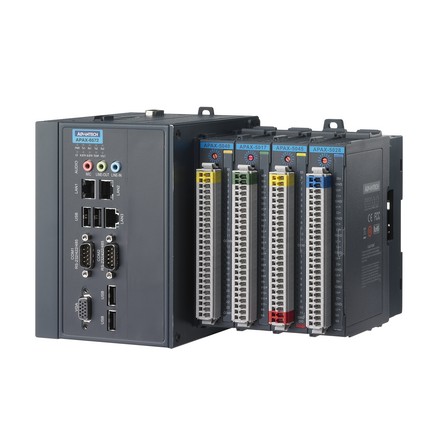AMAZON multi-meters discounts AMAZON oscilloscope discounts
1 Introduction
In this section, we look at the hardware and software that take the measurements from the field sensors and the instructions from the control system and provide the instructions to the final control elements that form the end points of the control loops in a plant.
In the past 30 years, there have been amazing changes in the design and construction of field controllers and the software that operates on them, while there have been many fewer changes in the design of the final control elements themselves.
It all started with Moore's law, of course. in the April 1965 issue of Electronics Magazine, Intel cofounder Gordon E. Moore described the doubling of electronic capabilities. "The complexity for minimum component costs has increased at a rate of roughly a factor of two per year …" he wrote. "Certainly over the short term this rate can be expected to continue, if not to increase." Even though there were and are pundits who believe that Moore's law will finally be exceeded, the cost and power of electronic products continues to follow his law. Costs drop by half and power increases by a factor of two every two years. This has now been going on for over 43 years. Every time it looks like there will be a slowdown, new processes are developed to continue to make more and more powerful electronics less expensively.
So, what has this meant? Manufacturing, indeed all of society, has been radically changed by the applications of Moore's law. in 1965, manufacturing was done with paper routers and instructions. Machining was done by hand, according to drawings. drawings themselves were done with pencil or India ink by draftspeople who did nothing else all day. Engineers used slide rules.
Machines were controlled by electromechanical relays and mechanical timers and human operators. if a new product was required, the production lines needed to be shut down, redesigned, rewired, and restarted, often at the cost of months of lost production.
The computers that put a man on the moon in 1969 had far less processing capability than the average inexpensive cell phone does in 2009.
![]() FIG.
1 Modicon (Schneider
Electric).
FIG.
1 Modicon (Schneider
Electric).
2 Field controllers, hardware, and software
In 1968, working on parallel paths, Richard Morley, of Bed ford Associates (later Modicon; see FIG. 1), and Otto Struger, of Allen-Bradley Co., created the first programmable logic controllers (PLCs). These devices were developed to replace hardwired discrete relay logic control systems in discrete manufacturing scenarios such as automotive assembly lines. The first PLCs used dedicated microprocessors running proprietary real-time operating systems (RToSs) and were programmed using a special programming language called "ladder logic," created by Morley and his associates. Ladder logic came about as a digital adaptation of the ladder diagrams electricians used to create relay logic prior to the advent of PLCs. The first generation PLCs had 4 kilo bytes of memory, maximum. They revolutionized industrial production, in both the discrete and the process fields.
In 1976, Robert Metcalfe, of Xerox, and his assistant, David Boggs, published Ethernet: Distributed Packet Switching For Local Computer Networks. Most computers and PLCs today use some form of Ethernet to move data.
The patents, interestingly, were not on the software but on the chips to produce hubs, routers, and the like, which had become practical because of Moore's law.
In 1981, Moore's law permitted IBM to release its first Personal Computer, or PC. it ran with 16 kilobytes of RAM on an Intel 4.88 MHz 8088 chip. Each of the original PCs was more powerful than the triple modular redundant computers that still (in 2009) drive the space shuttle.
By 1983, Moore's law had progressed to the point where a joint venture of Yamatake and Honeywell produced the first "smart transmitter." This was a field device: a pressure transmitter that had an onboard microprocessor transmitter- a computer inside a field instrument that could communicate digitally and be programmed like a computer. other companies quickly followed suit.
In 1996, Fisher-Rosemount inc., now Emerson Process Management, changed the definition of a distributed control system by combining a commercial off-the-shelf (CoTS) PC made by dell with a proprietary field controller and a suite of integrated proprietary software, running over standard Ethernet networks, and called it the deltaV. This device was possible only because Moore's law had made the PC powerful enough to replace the "big iron" proprietary computers used in previous dCS designs, both from Fisher-Rosemount and other vendors.
In 2002, Craig Resnick, an analyst with ARC Advisory Group, coined the name programmable automation controller (PAC) for an embedded PC running either a version of Windows or a proprietary RToS (see FIG. 2).
In 1968, process field controllers were of the analog type, standalone single-loop controllers. in 2009, even standalone single-loop controllers are digital microprocessor-based special-purpose computers. They may even be PACs.
The time since 1968 has seen the convergence of the discrete PLC controller and the process loop controller. Products like the Control Logix platform from Rockwell Automation (the successor to Allen-Bradley Co.), the Simatic S7 plat form from Siemens, the C200 platform from Honeywell, or any number of other PAC platforms now combine the discrete digital input/output features of the original PLCs and the advanced loop control functions of the analog single loop controller.
 FIG. 2 A programmable automation controller. Courtesy of Advantech inc.
FIG. 2 A programmable automation controller. Courtesy of Advantech inc.